In the British peerage, a royal duke is a member of the British royal family, entitled to the titular dignity of prince and the style of His Royal Highness , who holds a dukedom. Dukedoms are the highest titles in the British roll of peerage, and the holders of these particular dukedoms are princes of the blood royal. The holders of the dukedoms are royal, not the titles themselves. They are titles created and bestowed on legitimate sons and male-line grandsons of the British monarch, usually upon reaching their majority or marriage. [1] The titles can be inherited but cease to be called "royal" once they pass beyond the grandsons of a monarch. As with any peerage, once the title becomes extinct, it may subsequently be recreated by the reigning monarch at any time.
In the United Kingdom, there is nothing intrinsic to any dukedom that makes it "royal". Rather, these peerages are called royal dukedoms because they are created for, and held by, members of the royal family who are entitled to the titular dignity of prince and the style Royal Highness. Although the term "royal duke", therefore, has no official meaning per se, the category "Duke of the Blood Royal" was acknowledged as a rank conferring special precedence at court in the unrevoked 20th clause of the Lord Chamberlain's order of 1520. [2] [3] This decree accorded precedence to any peer related by blood to the sovereign above all others of the same degree within the peerage. The order did not apply within Parliament, nor did it grant precedence above the archbishop of Canterbury or other Great Officers of State such as is now enjoyed by royal dukes. But it placed junior "Dukes of the Blood Royal" above the most senior non-royal duke, junior "Earls of the Blood Royal" above the most senior non-royal earl (cf. Earldom of Wessex), etc. It did not matter how distantly related to the monarch the peers might be (presumably they ranked among each other in order of succession to the Crown). Although the 1520 order is theoretically still in effect, in fact the "Blood Royal" clause seems to have fallen into desuetude by 1917 when King George V limited the style of Royal Highness to children and male-line grandchildren of the sovereign. Thus peers of the blood royal who are neither sons nor grandsons of a sovereign are no longer accorded precedence above other peers.
Assuming that Alexander Windsor, Earl of Ulster and George Windsor, Earl of St Andrews succeed their fathers to become the third Duke of Gloucester and the third Duke of Kent, respectively, their peerages (as created in 1928 and 1934) will cease to be royal dukedoms; instead their holders will become "ordinary" dukes. [4] The third dukes of Gloucester and Kent will each be styled His Grace because, as great-grandsons of King George V, they are not princes and are not styled HRH. Similarly, upon the death of Prince Arthur, Duke of Connaught and Strathearn (1850–1942) (the third son of Queen Victoria), his only male-line grandson, Alastair, Earl of Macduff (1914–43), briefly succeeded to his peerages and was styled His Grace. Before the 1917 changes, his style had been His Highness Prince Alastair of Connaught.
The current royal dukedoms, held as principal titles, in order of precedence, are:
| Dukedom | Holder | Year created | Subsidiary titles |
|---|---|---|---|
| Duke of Sussex | Prince Harry | 2018 | Earl of Dumbarton Baron Kilkeel |
| Duke of York | Prince Andrew | 1986 | Earl of Inverness Baron Killyleagh |
| Duke of Edinburgh | Prince Edward | 2023 | Earl of Wessex Earl of Forfar Viscount Severn |
| Duke of Gloucester | Prince Richard | 1928 | Earl of Ulster Baron Culloden |
| Duke of Kent | Prince Edward | 1934 | Earl of St Andrews Baron Downpatrick |
The following dukedoms are currently held by William, Prince of Wales:
With the exceptions of the dukedoms of Cornwall and Rothesay (which can only be held by the eldest living son of the sovereign who is also the heir apparent), these dukedoms are hereditary according to the letters patent that created them. [1] Those patents contain the standard remainder to "heirs male of his body", with the exception of the Dukedom of Edinburgh, which is a life peerage and will become extinct on the death of the current Duke. [6]
By law the British monarch also holds, and is entitled to the revenues of, the Duchy of Lancaster. Within the borders of the County Palatine of Lancashire, therefore, the monarch is hailed as "The King/Queen, The Duke of Lancaster" (even when the monarch is a queen regnant, by tradition she does not use the title Duchess). [1] However, legally the monarch is not the Duke of Lancaster: peerages are in origin held feudally of the sovereign who, as the fount of honour, cannot hold a peerage of him- or herself. The situation is similar in the Channel Islands, where the monarch is addressed as Duke of Normandy, but only in accordance with tradition. He or she does not hold the legal title of Duke of Normandy.
The following is a list of dukedoms previously created for members of the royal family, but which have subsequently merged in the crown, become extinct or have otherwise ceased to be royal dukedoms.
| Title | Status | Notes |
|---|---|---|
| Duke of Albemarle | Deprived in 1399 | Non-royal dukedom created in 1660 (extinct 1688); non-royal Earldom of Albemarle (created 1697) is extant |
| Duke of Clarence [1] | Forfeit in 1478 | Earldom of Clarence (created 1881) is a subsidiary title of the suspended Dukedom of Albany |
| Duke of Clarence and Avondale | Extinct in 1892 | |
| Duke of Clarence and St Andrews | Merged in the crown in 1830 | Earldom of St Andrews (created 1934) is a subsidiary title of the extant Dukedom of Kent |
| Duke of Connaught and Strathearn [1] | Extinct in 1943 | Earldom of Strathearn (created 2011) is a subsidiary title of the extant Dukedom of Cambridge |
| Duke of Cumberland [1] | Extinct in 1765 | |
| Duke of Cumberland and Strathearn | Extinct in 1790 | |
| Duke of Gloucester and Edinburgh | Extinct in 1834 | Separate Dukedoms of Gloucester and Edinburgh are extant. |
| Duke of Hereford | Merged in the crown in 1399 | Non-royal Viscountcy of Hereford (created 1550) is extant |
| Duke of Kendal [1] | Extinct in 1667 | Non-royal dukedom created in 1719 (extinct 1743). |
| Duke of Kent and Strathearn | Extinct in 1820 | Earldom of Strathearn (created 2011) is a subsidiary title of the extant Dukedom of Cambridge. |
| Duke of Kintyre and Lorne | Extinct in 1602 | Non-royal Marquessate of Kintyre and Lorne (created 1701) is a subsidiary title of the extant Dukedom of Argyll |
| Duke of Ross | Extinct in 1515 | |
| Duke of Windsor | Extinct in 1972 | The title that was given to King Edward VIII after his abdication. Non-royal Barony (created 1529) and Viscountcy of Windsor (created 1905) are subsidiary titles of the extant Earldom of Plymouth. Non-royal Earldom of Windsor (created 1796) is a subsidiary title of the extant Marquessate of Bute. |
| Duke of York and Albany | Extinct in 1827 |
| Title | Royal creation | Current status |
|---|---|---|
| Duke of Bedford | Extinct in 1495 | Non-royal dukedom created in 1694 is extant |
| Duke of Norfolk | Extinct in 1483 | Non-royal dukedom created in 1483 is extant |
| Duke of Somerset | Extinct in 1500 | Non-royal dukedom created in 1547 is extant |
Under the Titles Deprivation Act 1917 the holders of the following dukedoms, who were simultaneously British princes and members of royal and princely families of Germany, were deprived of their British titles, having sided with Germany during the First World War. The Act provides that a successor of a person thus deprived of a peerage can petition the Crown for revival of the title. No such descendant has done so.
| Title | Created | Deprived holder | Current claimant |
|---|---|---|---|
| Duke of Albany [1] | 1881 | Charles Edward, Duke of Saxe-Coburg and Gotha | Prince Hubertus of Saxe Coburg and Gotha |
| Duke of Cumberland and Teviotdale | 1799 | Ernest Augustus, Crown Prince of Hanover | Prince Ernst August of Hanover |
While non-royal dukes are entitled to a coronet of eight strawberry leaves, to bear at a coronation and on his coat of arms, royal dukes are entitled to princely coronets (four cross pattées alternating with four strawberry leaves). The coronets of the royal family are dictated by letters patent. The Dukes of Sussex, of York and of Edinburgh bear by letters patent the coronet of a child of the sovereign (four crosses patées alternating with four fleurs-de-lis), while the Duke of Cornwall, Rothesay and Cambridge has use of the Prince of Wales' coronet, and the current dukes of Gloucester and of Kent, as grandsons of a sovereign bear the corresponding coronet of a royal duke.
At coronations, apart from the differentiation of princely coronets from ducal coronets, a royal duke is also entitled to six rows of ermine spots on his mantle, as opposed to the four rows borne by an "ordinary" duke.
| Family tree of Royal dukes in the United Kingdom | |||||||||||||||||||||||||||||||||||||||||||||||||||||||||||||||||||||||||||||||||||||||||||||||||||||||||||||||||||||||||||||||||||||||||||||||||||||||||||||||||||||||||||||||||||||||||||||||||||||||||||||||||||||||||||||||||||||||||||||||||||||||||||||||||||||||||||||||||||||||||||||||||||||||||||||||||||||||||||||||||||||||||||||||||||||||||||||||||||||||||||||||||||||||||||||||||||||||||||||||||||||||||||||||||||||||||||||||||||||||||||||||||||||||||||||||||||||||||||||||||||||||||||||||||||||||||||||||||||||||||||||||||||||||||||||||||||||||||||||||||||||||||||||||||||||||||||||||||||||||||||||||||||||||||||||||||||||||||||||||||||||||||||||||||||||||||||||||||||||||||||||||||||||||||||||||||||||||||||||||||||||||||||||||||||||||||||||||||||||||||||||||||||||||||||||||||||||||||||||||||||||||||||||||||||||||||||||||||||||||||||||||||||||||||||||||||||||||||||||||||||||||||||||||||||||||||||||||||||||||||||||||||||||||||||||||||||||||||||||||||||||||||||||||||||||||||||||||||||||||
|---|---|---|---|---|---|---|---|---|---|---|---|---|---|---|---|---|---|---|---|---|---|---|---|---|---|---|---|---|---|---|---|---|---|---|---|---|---|---|---|---|---|---|---|---|---|---|---|---|---|---|---|---|---|---|---|---|---|---|---|---|---|---|---|---|---|---|---|---|---|---|---|---|---|---|---|---|---|---|---|---|---|---|---|---|---|---|---|---|---|---|---|---|---|---|---|---|---|---|---|---|---|---|---|---|---|---|---|---|---|---|---|---|---|---|---|---|---|---|---|---|---|---|---|---|---|---|---|---|---|---|---|---|---|---|---|---|---|---|---|---|---|---|---|---|---|---|---|---|---|---|---|---|---|---|---|---|---|---|---|---|---|---|---|---|---|---|---|---|---|---|---|---|---|---|---|---|---|---|---|---|---|---|---|---|---|---|---|---|---|---|---|---|---|---|---|---|---|---|---|---|---|---|---|---|---|---|---|---|---|---|---|---|---|---|---|---|---|---|---|---|---|---|---|---|---|---|---|---|---|---|---|---|---|---|---|---|---|---|---|---|---|---|---|---|---|---|---|---|---|---|---|---|---|---|---|---|---|---|---|---|---|---|---|---|---|---|---|---|---|---|---|---|---|---|---|---|---|---|---|---|---|---|---|---|---|---|---|---|---|---|---|---|---|---|---|---|---|---|---|---|---|---|---|---|---|---|---|---|---|---|---|---|---|---|---|---|---|---|---|---|---|---|---|---|---|---|---|---|---|---|---|---|---|---|---|---|---|---|---|---|---|---|---|---|---|---|---|---|---|---|---|---|---|---|---|---|---|---|---|---|---|---|---|---|---|---|---|---|---|---|---|---|---|---|---|---|---|---|---|---|---|---|---|---|---|---|---|---|---|---|---|---|---|---|---|---|---|---|---|---|---|---|---|---|---|---|---|---|---|---|---|---|---|---|---|---|---|---|---|---|---|---|---|---|---|---|---|---|---|---|---|---|---|---|---|---|---|---|---|---|---|---|---|---|---|---|---|---|---|---|---|---|---|---|---|---|---|---|---|---|---|---|---|---|---|---|---|---|---|---|---|---|---|---|---|---|---|---|---|---|---|---|---|---|---|---|---|---|---|---|---|---|---|---|---|---|---|---|---|---|---|---|---|---|---|---|---|---|---|---|---|---|---|---|---|---|---|---|---|---|---|---|---|---|---|---|---|---|---|---|---|---|---|---|---|---|---|---|---|---|---|---|---|---|---|---|---|---|---|---|---|---|---|---|---|---|---|---|---|---|---|---|---|---|---|---|---|---|---|---|---|---|---|---|---|---|---|---|---|---|---|---|---|---|---|---|---|---|---|---|---|---|---|---|---|---|---|---|---|---|---|---|---|---|---|---|---|---|---|---|---|---|---|---|---|---|---|---|---|---|---|---|---|---|---|---|---|---|---|---|---|---|---|---|---|---|---|---|---|---|---|---|---|---|---|---|---|---|---|---|---|---|---|---|---|---|---|---|---|---|---|---|---|---|---|---|---|---|---|---|---|---|---|---|---|---|---|---|---|---|---|---|---|---|---|---|---|---|---|---|---|---|---|---|---|---|---|---|---|---|---|---|---|---|---|---|---|---|---|---|---|---|---|---|---|---|---|---|---|---|---|---|---|---|---|---|---|---|---|---|---|---|---|---|---|---|---|---|---|---|---|---|---|---|---|---|---|---|---|---|---|---|---|---|---|---|---|---|---|---|---|---|---|---|---|---|---|---|---|---|---|---|---|---|---|---|---|---|---|---|---|---|---|---|---|---|---|---|---|---|---|---|---|---|---|---|---|---|---|---|---|---|---|---|---|---|---|---|---|---|---|---|---|---|---|---|---|---|---|---|---|---|---|---|---|---|---|---|---|---|---|---|---|---|---|---|---|---|---|---|---|---|---|---|---|---|---|---|---|---|---|---|---|---|---|---|---|---|---|---|---|---|---|---|---|---|---|---|---|---|---|---|---|---|---|---|---|---|---|---|---|---|---|---|---|---|---|---|---|---|---|---|---|---|---|---|---|---|---|---|---|---|---|---|---|---|---|---|---|---|---|---|---|---|---|---|---|---|---|---|---|---|---|---|---|---|---|---|---|---|---|---|---|---|---|---|---|---|---|---|---|---|---|---|---|---|---|---|---|---|---|---|---|---|---|---|---|---|---|---|---|---|---|---|---|---|---|---|---|---|---|---|---|---|---|---|---|---|---|---|---|---|---|---|---|---|---|---|---|---|---|---|---|---|---|---|---|---|---|
Non-royal dukes are not included; see Royal dukedoms in the United Kingdom . Includes dukes of: Albany, Albemarle, Bedford, Cambridge, Clarence, Connaught and Strathearn, Cumberland, Edinburgh, Gloucester, Gloucester and Edinburgh, Kent, Kintyre and Lorne, Norfolk, Ross, Somerset, Sussex, Windsor, and York, but only when royally.
| |||||||||||||||||||||||||||||||||||||||||||||||||||||||||||||||||||||||||||||||||||||||||||||||||||||||||||||||||||||||||||||||||||||||||||||||||||||||||||||||||||||||||||||||||||||||||||||||||||||||||||||||||||||||||||||||||||||||||||||||||||||||||||||||||||||||||||||||||||||||||||||||||||||||||||||||||||||||||||||||||||||||||||||||||||||||||||||||||||||||||||||||||||||||||||||||||||||||||||||||||||||||||||||||||||||||||||||||||||||||||||||||||||||||||||||||||||||||||||||||||||||||||||||||||||||||||||||||||||||||||||||||||||||||||||||||||||||||||||||||||||||||||||||||||||||||||||||||||||||||||||||||||||||||||||||||||||||||||||||||||||||||||||||||||||||||||||||||||||||||||||||||||||||||||||||||||||||||||||||||||||||||||||||||||||||||||||||||||||||||||||||||||||||||||||||||||||||||||||||||||||||||||||||||||||||||||||||||||||||||||||||||||||||||||||||||||||||||||||||||||||||||||||||||||||||||||||||||||||||||||||||||||||||||||||||||||||||||||||||||||||||||||||||||||||||||||||||||||||||||
Peerages in the United Kingdom form a legal system comprising both hereditary and lifetime titles, composed of various ranks, and within the framework of the Constitution of the United Kingdom form a constituent part of the legislative process and the British honours system. The British monarch is considered the fount of honour and is notionally the only person who can grant peerages, though there are many conventions about how this power is used, especially at the request of the British government. The term peerage can be used both collectively to refer to the entire body of titled nobility, and individually to refer to a specific title. British peerage title holders are termed peers of the Realm.

Duke is a male title either of a monarch ruling over a duchy, or of a member of royalty, or nobility. As rulers, dukes are ranked below emperors, kings, grand princes, grand dukes, and sovereign princes. As royalty or nobility, they are ranked below princes and grand dukes. The title comes from French duc, itself from the Latin dux, 'leader', a term used in republican Rome to refer to a military commander without an official rank, and later coming to mean the leading military commander of a province. In most countries, the word duchess is the female equivalent.

Duke of Norfolk is a title in the peerage of England, and is the premier non-royal peerage. The seat of the Duke of Norfolk is Arundel Castle in Sussex, although the title refers to the county of Norfolk. The current duke is Edward Fitzalan-Howard, 18th Duke of Norfolk. The dukes have historically been Catholic, a state of affairs known as recusancy in England.
Duke of Cornwall is a title in the Peerage of England, traditionally held by the eldest son of the reigning British monarch, previously the English monarch. The Duchy of Cornwall was the first duchy created in England and was established by a royal charter in 1337. Prince William became Duke of Cornwall following the accession of his father, King Charles III, to the throne in 2022, and his wife, Catherine, became Duchess of Cornwall.
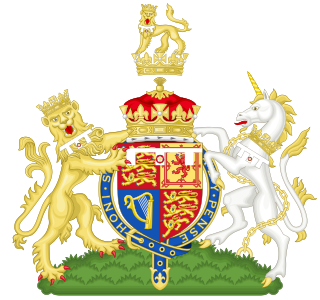
Duke of Edinburgh, named after the city of Edinburgh in Scotland, is a substantive title that has been created four times since 1726 for members of the British royal family. It does not include any territorial landholdings and does not produce any revenue for the title-holder.

Duke of Gloucester is a British royal title, often conferred on one of the sons of the reigning monarch. The first four creations were in the Peerage of England and the last in the Peerage of the United Kingdom; the current creation carries with it the subsidiary titles of Earl of Ulster and Baron Culloden.

Duke of Rothesay is the main dynastic title traditionally given to the male heir apparent to the Scottish and, later, British thrones. The dukedom was created in 1398 by Robert III of Scotland for his eldest son.
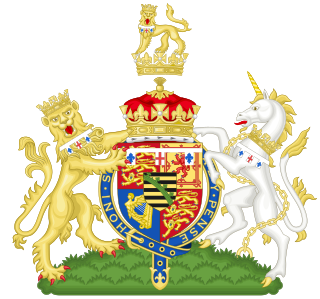
Duke of Connaught and Strathearn was a title in the Peerage of the United Kingdom that was granted on 24 May 1874 by Queen Victoria of the United Kingdom of Great Britain and Ireland to her third son, Prince Arthur. At the same time, he was also granted the subsidiary title of Earl of Sussex.

Duke of Kent is a title that has been created several times in the peerages of Great Britain and the United Kingdom, most recently as a royal dukedom for the fourth son of King George V. Since 1942, the title has been held by Prince Edward, Queen Elizabeth II's cousin.
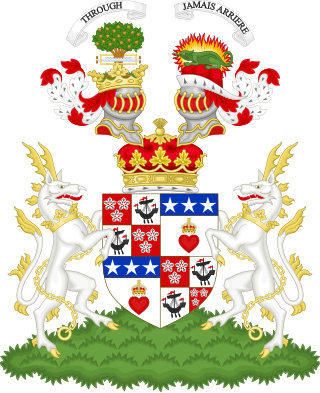
Duke of Hamilton is a title in the Peerage of Scotland, created in April 1643. It is the senior dukedom in that peerage, and as such its holder is the premier peer of Scotland, as well as being head of both the House of Hamilton and the House of Douglas. The title, the town of Hamilton in Lanarkshire, and many places around the world are named after members of the Hamilton family. The ducal family's surname, originally "Hamilton", is now "Douglas-Hamilton". Since 1711, the dukedom has been held together with the Dukedom of Brandon in the Peerage of Great Britain, and the dukes since that time have been styled Duke of Hamilton and Brandon, along with several other subsidiary titles.
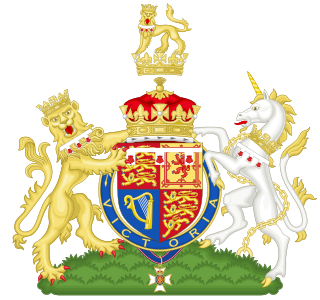
Duke of Sussex is a substantive title, one of several royal dukedoms in the Peerage of the United Kingdom. It is a hereditary title of a specific rank of nobility in the British royal family. It has been created twice and takes its name from the historic county of Sussex in England.
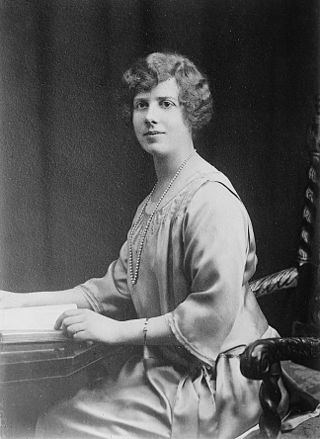
Maud Carnegie, Countess of Southesk, titled Princess Maud from 1905 to 1923, was a granddaughter of Edward VII. Maud and her elder sister, Alexandra, had the distinction of being the only female-line descendants of a British sovereign officially granted both the title of Princess and the style of Highness.

Marquess of Cambridge was a title that was created twice, once in the Peerage of England and once in the Peerage of the United Kingdom.
The hereditary peers form part of the peerage in the United Kingdom. As of August 2023, there are 805 hereditary peers: 30 dukes, 34 marquesses, 189 earls, 110 viscounts, and 442 barons.
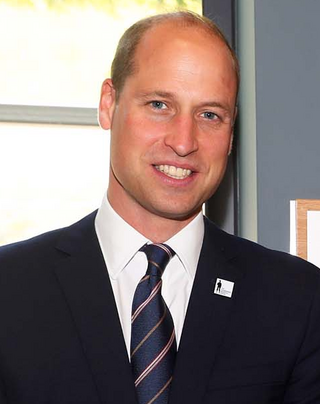
Prince of the United Kingdom of Great Britain and Northern Ireland is a royal title normally granted to sons and grandsons of reigning and past British monarchs, together with consorts of female monarchs. The title is granted by the reigning monarch, who is the fount of all honours, through the issuing of letters patent as an expression of the royal will.

The use of the title of Princess of the United Kingdom of Great Britain and Northern Ireland is entirely at the will of the sovereign, and is now expressed in letters patent. Individuals holding the title of princess are styled "Her Royal Highness" (HRH). The current letters patent were issued in 1917 during the First World War, with one extension in 2012.

Duke of Kent and Strathearn is a title that was created once in the Peerage of Great Britain.
Duke, in the United Kingdom, is the highest-ranking hereditary title in all five peerages of the British Isles. A duke thus outranks all other holders of titles of nobility.